Hasanamba Temple: Stone Sleeps & Spirit Awakes
The Hasanamba Temple, nestled in the heart of Hassan, Karnataka, India, boasts a rich and fascinating history that intertwines with mythology, artistic brilliance, and intriguing customs. Dedicated to the powerful Goddess Shakti, also known as Amba, the temple’s origins can be traced back to the 12th century, during the reign of the Hoysala dynasty.
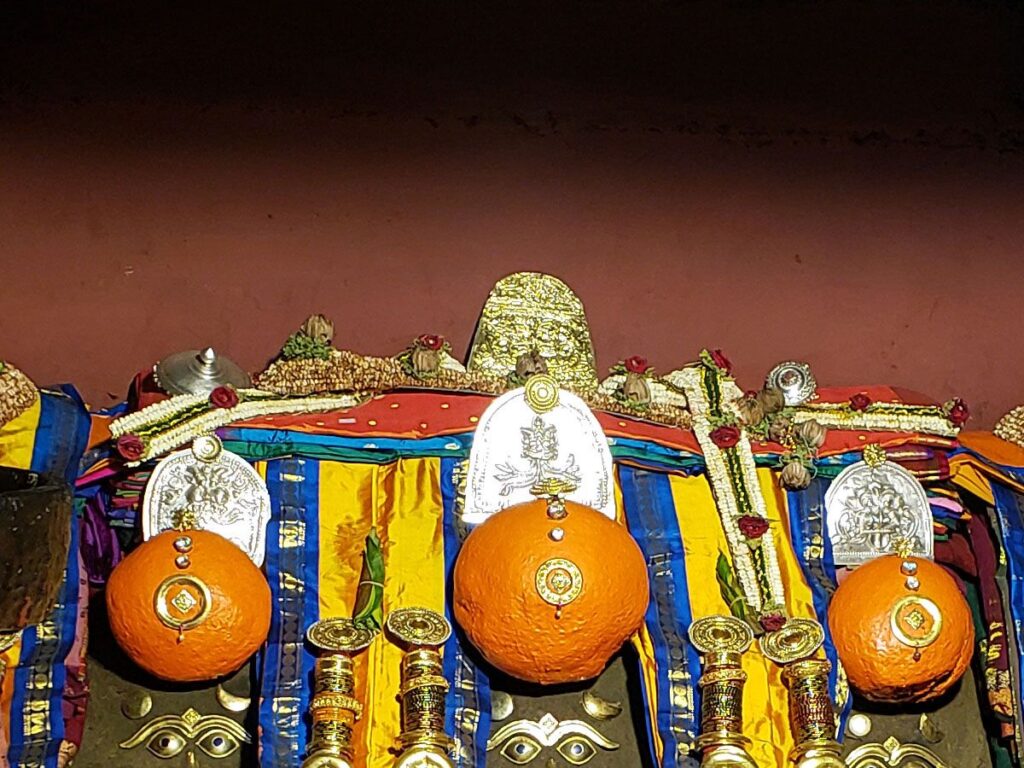
Contents
Hasanamba Temple History:
Mythological Origins of Hasanamba Temple:
Legend whispers of the seven Maatrukas, fierce forms of Shakti – Brahmi, Maheshwari, Kaumari, Vyshnavi, Indrani, Varahi, and Chamundi – who arrived in South India, captivated by the beauty of Hassan. While Varahi and Chamundi chose nearby Devigere Honda, Vyshnavi, Kaumari, and Maheshwari settled within three anthills inside the temple complex. Brahmi, seeking solitude, found her abode in Kenchamma’s Hoskote.
Historical Glimpses:
While the exact builders of the temple remain unknown, evidence suggests construction during the reign of the Hoysala dynasty. The Hoysalas, renowned for their architectural prowess, have left their mark on the temple’s intricate carvings and sculptures.
Unique Traditions:
One of the most intriguing aspects of the Hasanamba Temple is its unique opening schedule. Unlike most temples open daily, the Hasanamba Temple opens its doors only once a year, during the auspicious festival of Deepavali in October. This annual event attracts thousands of devotees eager to seek the blessings of the Goddess.
Architectural Marvels:
The temple boasts a captivating architectural style, blending Hoysala and Dravidian elements. The sanctum sanctorum houses the idol of Goddess Hasanamba, adorned with intricate jewelry and exuding an aura of divine power. The outer walls are adorned with friezes depicting scenes from Hindu mythology, showcasing the skill of Hoysala artisans.
Read More>> Masani Amman Temple Coimbatore
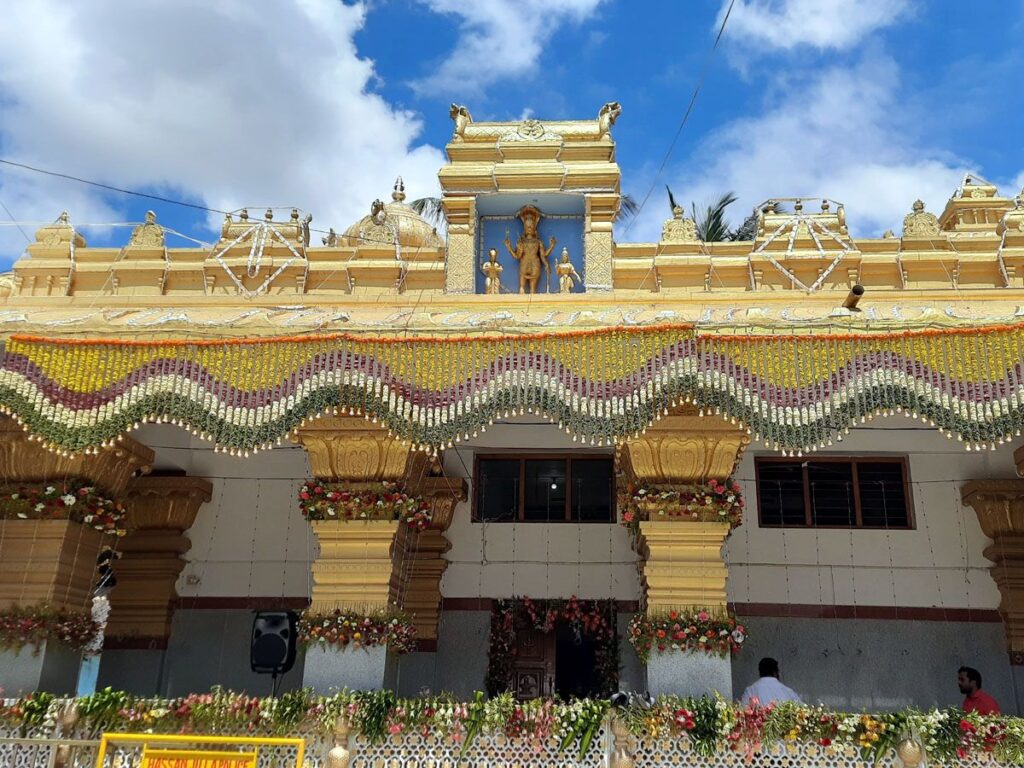
Legend of Hasanamba Temple:
The Descent of the Divine Mothers:
Legend has it that once upon a time, the seven Matrika goddesses, fierce manifestations of Shakti, embarked on a celestial journey to Earth. The serene beauty of Hassan captivated them, and they decided to make it their abode. While Varahi and Chamundi settled near the holy wells of Devigere Honda, the other four sisters – Vyshnavi, Kaumari, Maheshwari, and Brahmi – chose the three anthills within the temple complex as their dwelling places.
The Ever-Smiling Goddess:
The name Hasanamba itself speaks volumes about the goddess’s benevolent nature. “Hasya” in Kannada translates to smile, and Hasanamba is revered for her ever-present grin, showering her devotees with blessings and prosperity. However, her compassion is said to be balanced with unwavering justice. Tales abound of her harsh retribution towards those who harm her devotees.
The Moving Stone and the End of Kali Yuga:
One of the most intriguing legends surrounding the temple revolves around a seemingly ordinary stone called “Sose kallu,” meaning “daughter-in-law’s stone.” Devotees believe that this stone, representing a woman who sought refuge in the temple from her cruel mother-in-law, miraculously moves towards the idol of Hasanamba by a fraction of a millimeter every year. When the stone finally touches the goddess, it signifies the end of the present Kali Yuga, a period of darkness and chaos, ushering in a new era of righteousness.
Eternal Guardians:
Another captivating legend speaks of four thieves who, blinded by greed, attempted to steal the precious jewels adorning the goddess. As punishment for their sacrilegious act, Hasanamba transformed them into stone statues, forever standing as a grim reminder of her divine wrath. These petrified figures, known as “Kallappana Gudi,” or “thief’s hut,” serve as eternal guardians, watching over the temple and deterring any future acts of misdeed.
Hasanamba Temple’s legends are not merely stories; they are threads woven into the fabric of the temple’s identity. They speak of divine grace, unwavering justice, and the enduring power of faith. Whether you believe them to be true or not, these tales add a layer of enchantment to this sacred place, making a visit to Hasanamba Temple an experience that transcends the physical and delves into the realm of the divine.
Read More>> Enchanting Chidambaram Nataraja Temple: Formless Akasha Lingam

Significance of Hasanamba Temple:
Religious Significance:
- Dedicated to Goddess Shakti: The temple is primarily dedicated to Goddess Shakti, revered in the form of Hasanamba, meaning “ever-smiling” or “always happy.” Devotees believe the benevolent goddess blesses them with prosperity, good health, and wisdom.
- Unique Darshan: Unlike most temples open daily, the Hasanamba Temple opens only once a year during the Chaitra month (March-April) on a Friday preceding the Navaratri festival. This unique “darshan” (viewing) attracts thousands of devotees eager to seek the goddess’s blessings. Mythology and Legends: Several myths and legends surround the temple, adding to its mystique. One popular belief involves the seven Matrukas (divine mothers) choosing Hassan as their abode due to its scenic beauty. Another legend suggests a moving stone (“sose kallu”) slowly inching towards the goddess’s idol. When it touches the idol, it’s believed to mark the end of the current Kali Yuga (age of darkness).
Historical Significance:
- Architectural Marvel: Built in the 12th century, the temple showcases the Hoysala architectural style, known for its intricate carvings and sculptures. The intricate friezes depicting mythological scenes and daily life offer a glimpse into Hoysala culture.
- Royal Connection: The Hoysala kings patronized the temple’s construction, evident in the inscriptions and royal emblems found within the temple complex.
- Symbol of Cultural Heritage: The Hasanamba Temple stands as a testament to the rich cultural heritage of Karnataka, attracting history enthusiasts and art connoisseurs alike.
Social Significance:
- Festivals and Celebrations: The annual opening of the temple during Chaitra is a major festival in Hassan, marked by vibrant processions, cultural performances, and devotional fervor.
- Community Bonding: The temple serves as a unifying force for the local community, bringing people together for religious observances and celebrations.
- Economic Impact: The temple’s annual opening attracts tourists and pilgrims, boosting the local economy through hospitality, transportation, and souvenir sales.
Read More>> Gauthameswarar Temple Kumbakonam
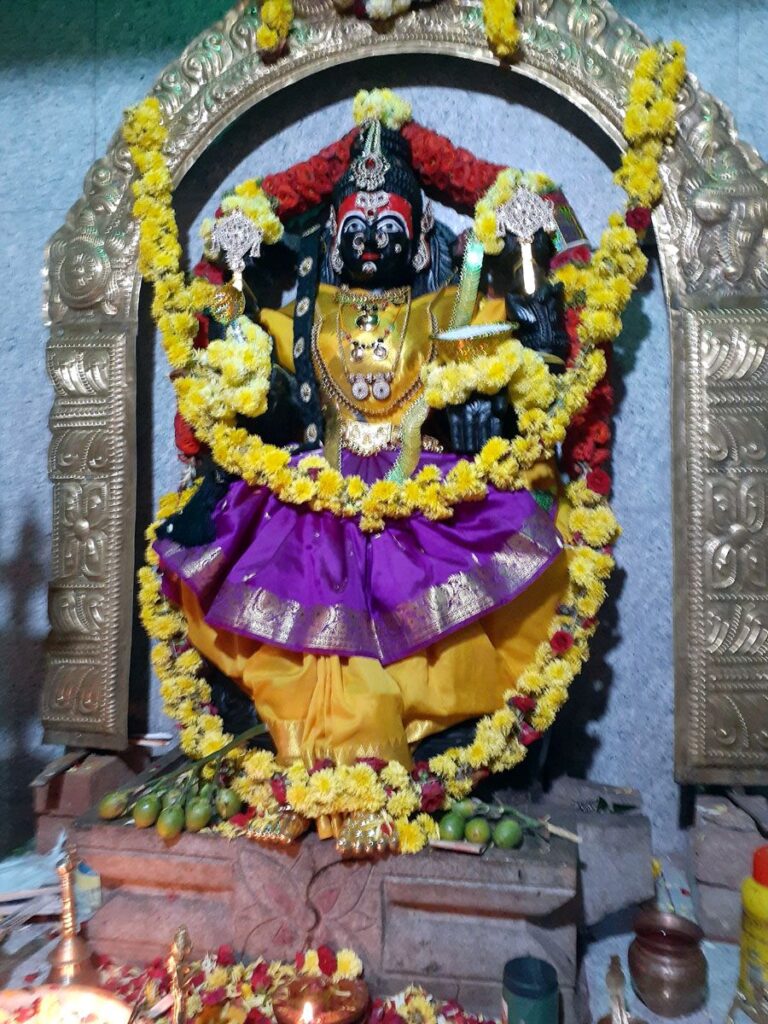
Myths of Hasanamba Temple:
The Moving Stone: A large stone called the “Sose Kallu” (Daughter-in-law’s Stone) is believed to be moving towards the idol of Goddess Hasanamba by a fraction of a millimeter every year. When it reaches the idol, it is said to mark the end of the present Kali Yuga (the age of darkness and ignorance).
The Punished Robbers: Four stones in the temple complex are said to be petrified robbers who attempted to steal the temple’s jewels. Goddess Hasanamba turned them into stone as punishment for their misdeeds.
The Boon of Invincibility: According to legend, a demon named Andhakasura obtained a boon from Brahma that made him invincible. However, a loophole in the boon allowed Goddess Hasanamba to slay him. This story highlights the power and wisdom of the goddess.
The Seven Matrikas: The seven Matrikas, fierce forms of Goddess Durga, are said to have been so captivated by the beauty of Hassan that they decided to reside there. This legend explains the presence of shrines dedicated to the Matrikas in the temple complex.
The Restricted Darshan: The idol of Goddess Hasanamba is only open for public viewing for a week during Diwali. This limited darshan adds to the mystique of the temple and fuels belief in the goddess’s immense power.
Read More>> Arunachaleswara Temple
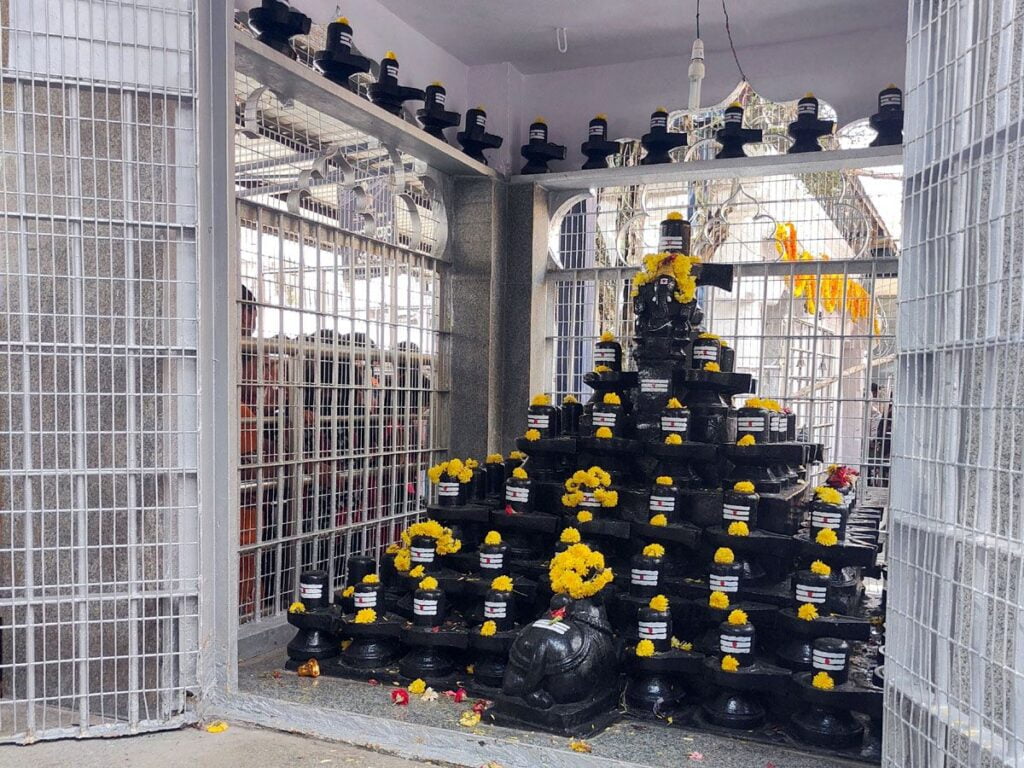
Hasanamba Temple Timing and Rituals:
Timings:
The temple is open from 6:00 AM to 8:00 PM. The darshan timings are as follows:
- Morning: 6:00 AM to 12:00 PM
- Evening: 4:00 PM to 8:00 PM
Rituals:
The following rituals are performed daily at the temple:
- Abhishekam: This is a ritualistic bath performed on the deity with milk, water, and other sacred ingredients.
- Alankaram: This is the dressing of the deity with ornaments and flowers.
- Naivedyam: This is the offering of food to the deity.
- Arati: This is the waving of a lamp before the deity.
Special pujas:
The following special pujas are performed at the temple on specific occasions:
- Srivari Utsavam: This is a 10-day festival celebrated in April-May.
- Dasara: This is a 10-day festival celebrated in September-October.
- Karthika Masam: This is a holy month dedicated to Lord Shiva and Goddess Parvati.
- Maha Shivaratri: This is a festival celebrated in February-March.
Read More>> Vijayawada Kanaka Durga Temple: A Beacon of Hope & Strength
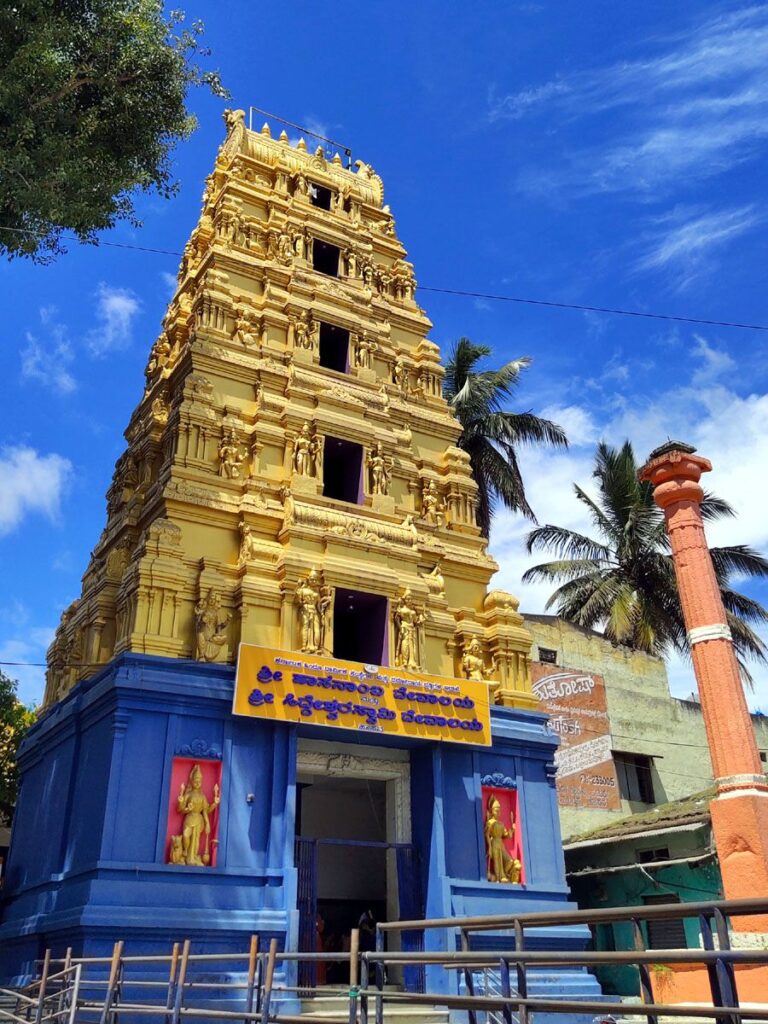
Hasanamba Temple Festivals:
The Hasanamba Temple in Hassan, Karnataka, India, is famous for its unique tradition of being open only during the annual Hasanamba Jatra Mahotsava (festival). This celebration occurs around the Hindu festival of Deepavali (Diwali), usually in October. While the temple itself is closed for most of the year, this week-long event draws thousands of devotees from all over India.
Here’s what you can expect during the Hasanamba Temple festival:
Opening of the Temple:
- The highlight of the festival is the opening of the temple’s sanctum sanctorum, which remains closed for the rest of the year. This allows devotees to have a “darshan” (holy sight) of the idol of Goddess Hasanamba, a powerful form of Goddess Shakti.
- The opening ceremony is a grand affair, with processions, chanting, and traditional music and dance performances.
Festivities and Rituals:
- The festival is filled with vibrant cultural events, including:
- Colorful rangoli patterns on the temple floor
- Performances of traditional folk dances like Yakshagana and Dollu Kunitha
- Music concerts and devotional songs
- Food stalls offering a variety of delicacies
- Religious rituals like puja (worship), abhisheka (holy bath for the idol), and homa (fire sacrifice) are also conducted throughout the week.
Significance of the Festival:
- For Hindus, visiting the Hasanamba Temple during the festival is considered auspicious and believed to bring blessings and prosperity.
- The unique tradition of the temple opening only for a limited time adds to its mystical charm and makes it a truly special experience for devotees.
Read More>> Subramanya Swamy Temple Thiruparankunram
Places to visit near Hasanamba Temple:
- Shravanabelagola: Famous for the colossal Gommateshwara statue, Shravanabelagola is an important Jain pilgrimage site. The statue is located on Vindhyagiri Hill, and the climb offers panoramic views of the surrounding area.
- Belur and Halebidu: These historic towns are renowned for their Hoysala architecture. Belur is home to the Chennakesava Temple, while Halebidu boasts the Hoysaleswara Temple. Both are UNESCO World Heritage Sites.
- Channarayapatna: Known for its traditional crafts, particularly wooden toys and crafts. It’s a good place to explore local craftsmanship.
- Gorur Dam: Located about 20 kilometers from Hassan, Gorur Dam is a serene place with a beautiful reservoir. The dam is built across the river Hemavathi.
- Manjarabad Fort: A star-shaped fort built by Tipu Sultan, offering panoramic views of the Western Ghats. It’s about 6 kilometers from Sakleshpur.
- Hassanamba Museum: If you are interested in learning more about the history and culture of the region, the museum in Hassan could be a good place to visit.
- Kedareshwara Temple, Halebidu: Another Hoysala temple in Halebidu, dedicated to Lord Shiva. It’s known for its intricate carvings.
- Gorur Hemavathi Reservoir: Apart from the dam, the surrounding area provides a peaceful environment for picnics and relaxation.
- Bisle Ghat Viewpoint: If you enjoy nature, consider visiting Bisle Ghat for breathtaking views of the Western Ghats.
FAQ:
Q: Where is the Hasanamba Temple located?
A: The Hasanamba Temple is located in Hassan, Hassan District, Karnataka, India. It sits at the heart of the city and is considered its namesake deity.
Q: When is the Hasanamba Temple open?
A: The Hasanamba Temple is famously known for opening only once a year for around 10-15 days during the Hindu festival of Deepavali, which falls in October or November. This unique tradition adds to the temple’s mystique and attracts devotees from all over India.
Q: What is the significance of the Hasanamba Temple?
A: The Hasanamba Temple is dedicated to Goddess Shakti, also known as Amba. She is revered as a powerful manifestation of the divine feminine and is worshipped for her blessings of prosperity, health, and protection. The temple holds immense cultural and historical significance for the people of Hassan and Karnataka.
Q: What are the architectural features of the Hasanamba Temple?
A: The Hasanamba Temple is a fine example of Hoysala architecture, known for its intricate carvings and sculptures. The temple complex comprises three major temples – the Hasanamba temple itself, the Darbar Ganapati temple, and the Siddeshwara temple. Each temple boasts unique architectural elements and contributes to the overall grandeur of the complex.
Q: Can I visit the Hasanamba Temple outside of Deepavali?
A: While the main temple dedicated to Goddess Hasanamba opens only during Deepavali, the other two temples within the complex – Darbar Ganapati and Siddeshwara – are open throughout the year. These temples offer a glimpse into the temple’s architectural beauty and spiritual atmosphere even when the main sanctum is closed.
Q: How can I plan my trip to the Hasanamba Temple during Deepavali?
A: If you wish to witness the grand opening of the Hasanamba Temple during Deepavali, it’s crucial to plan your trip well in advance. Booking accommodation and transportation early is essential, as the city experiences a surge in visitors during this time. Be prepared for long queues and crowds, especially during the darshan of the Goddess.
Q: What is special about Hasanamba Temple?
A: The Hasanamba Temple is special for a few key reasons:
1. Unique Opening: Unlike most temples open year-round, Hasanamba Temple opens its doors for just 10-15 days during Deepavali (October or November). This exclusivity adds to its mystique and draws devotees from far and wide.
2. Goddess Shakti: Dedicated to Goddess Shakti, the temple pulsates with powerful feminine energy. Devotees seek blessings for prosperity, health, and protection from the fierce yet benevolent Amba.
3. Hoysala Architecture: The intricate carvings and sculptures adorning the temple are testaments to the glorious Hoysala architectural style. Each detail, from the ornate pillars to the mythical creatures, tells a story, captivating visitors.
4. Moving Stone: Legend has it a stone inside the temple moves a fraction of a millimeter closer to the Goddess’s idol every year. When it touches the idol, it signifies the end of the Kali Yuga, adding to the temple’s mystical aura.
5. Cultural Significance: The Hasanamba Temple is deeply woven into the cultural fabric of Hassan and Karnataka. Its annual opening is a joyous occasion celebrated with vibrant rituals and traditional fervor.
Q: Why Hasanamba Temple is open only once a year?
A: There are two main reasons why the Hasanamba Temple opens only once a year:
1. Mystery and Devotion: The limited opening adds an aura of mystery and exclusivity, fueling devotees’ desire to experience the temple’s unique energy during Deepavali. It’s a special occasion, not just a routine visit.
2. Practicality: Keeping the temple closed for most of the year allows for maintenance, prevents wear and tear from constant crowds, and ensures the offerings left for the Goddess remain fresh for her annual opening.
How to reach Hasanamba Temple:
- By Air:
- The nearest airport is the Kempegowda International Airport (BLR) in Bangalore, which is approximately 183 kilometers away from Hassan.
- From the airport, you can hire a taxi or use other transportation options to reach Hassan.
- By Train:
- Hassan has a railway station, and there are regular trains connecting it to major cities in Karnataka and other parts of India.
- Once you reach the Hassan railway station, you can hire a taxi or use local transportation to reach the Hasanamba Temple.
- By Road:
- Hassan is well-connected by road, and there are regular bus services from Bangalore and other nearby cities.
- If you are driving, you can use a GPS navigation system to guide you to Hassan. The temple is typically well-known, and locals can provide directions as well.
- Local Transportation:
- Once you reach Hassan, you can hire a taxi or an auto-rickshaw to take you to the Hasanamba Temple. Make sure to confirm the location with the driver before starting your journey.
